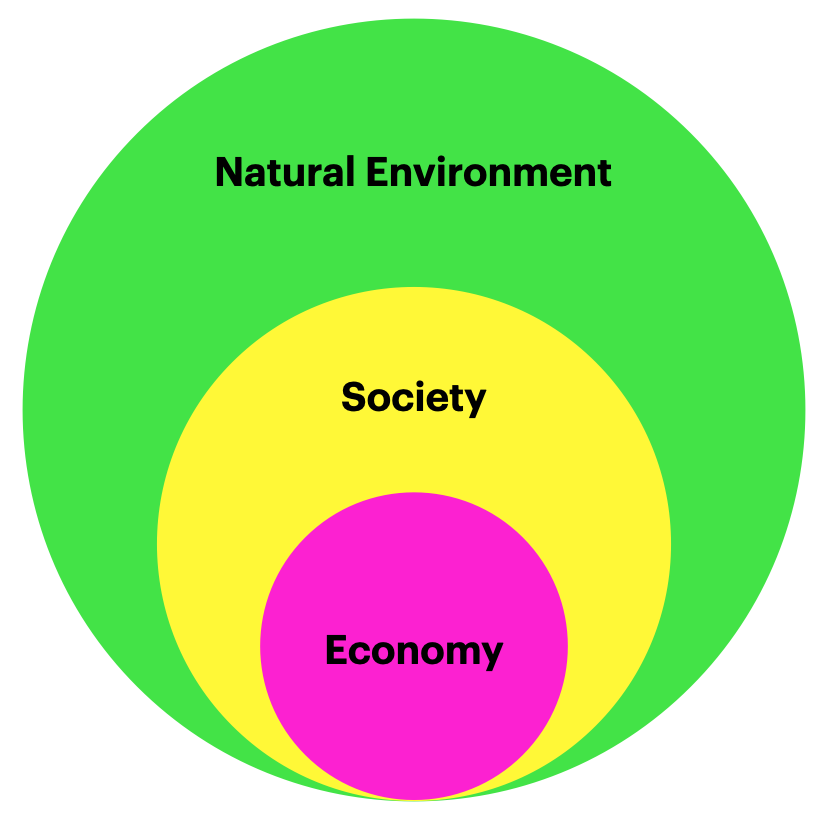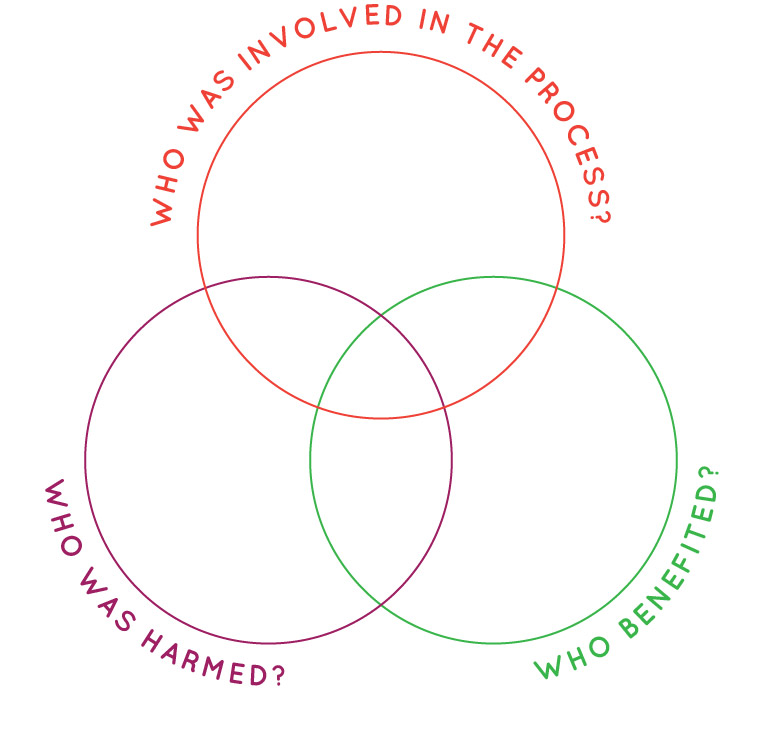Can we decarbonise digital?
According to the UNDP, digital technologies are projected to become the second-largest contributor to climate change, just behind the USA. By 2040, the digital industry could be responsible for a staggering 14% of global emissions. While the evolution and widespread adoption of digital technology have brought numerous benefits and advancements to people worldwide, both for the better and sometimes worse, the environmental consequences often go unnoticed by us as users and designers.
Ways to think about sustainabilty
To comply with the Paris Agreement's aim to keep global warming to 1.5 °C above pre-industrial levels, we need a drastic decrease in resource use while keeping life comfortable for all life on the planet. Digital technology is both a challenge and a tool in this endeavour to shift to a low-carbon economy, as digital tech is subject to the same limitations as other systems.
Keeping in mind that "all models are wrong, but some are useful"; to understand the environmental impact of our daily activities, we can turn to the Nested Dependencies Model. which visualises the interdependence of the environment, society, and economy as a nested system. This model highlights that a thriving society and economy are reliant on a healthy natural environment. The well-being of the environment directly affects the functioning of society and the economy.
Keeping in mind that "all models are wrong, but some are useful"; to understand the environmental impact of our daily activities, we can turn to the Nested Dependencies Model. which visualises the interdependence of the environment, society, and economy as a nested system. This model highlights that a thriving society and economy are reliant on a healthy natural environment. The well-being of the environment directly affects the functioning of society and the economy.

Adapted from: Moir, S., & Carter, K. (2012, September). Diagrammatic representations of sustainability–a review and synthesis. In Procs 28th Annual ARCOM Conference (pp. 3-5). Association of Researchers in Construction Management Edinburgh.
In 1969, Herbert Simon defined design as the process of devising "courses of action aimed at changing existing situations into preferred ones". This definition implies that many of us can be considered designers, holding both power and responsibility for what we create. Another valuable perspective to consider when evaluating the sustainability of our creations is the Design Justice Principles' Venn diagram. This framework aims to distinguish design justice from well-meaning approaches like "design for social impact" or "design for good" that often overlook potentially harmful aspects ingrained within prevailing power structures.
Although these models only show certain aspects of an issue, using these to think with can help us see through the superficial and greenwashing tendencies of sustainability initiatives.
Although these models only show certain aspects of an issue, using these to think with can help us see through the superficial and greenwashing tendencies of sustainability initiatives.

https://designjustice.org/news-1/2016/05/02/2016-generating-shared-principles
Decarbonisation of Digital
According to recommendations that come out from research by SFU School for the Contemporary Arts, "all sectors need to move to renewable energy as quickly as possible", although decarbonisation on its own is not enough. They also highlight that:
"The Internet is a finite system. The miniaturization that led advances in computing for decades (Moore’s Law) is coming to an end. Thus, energy efficiency cannot be the only solution: an absolute decrease in energy consumption is necessary...Scenarios in which ICT is powered by renewable energy and we can continue to consume all we want are unlikely.”
With this in mind, I have explored how to start reconciling the need for decarbonising society with a focus on the digital media sector, with the realities of being a digital craftsperson, developer or pretty much anyone who uses computers or the internet as part of making their living.
Returning to the 'Economy' sector of the Nested Dependencies Model, which often becomes the focal point of our efforts, reconciling economic needs and the existing system with environmental and social needs requires a step-by-step approach. Even if we may want to work on big ideas for change, we may have to start in a way that is realistic and viable.
Although the environmental impact of digital media encompasses more than just carbon emissions, the rising level of CO2 equivalents in the atmosphere is a key driver of climate change. Unlike our impact on biodiversity and freshwater quality, carbon emissions are more tangible and measurable.
Returning to the 'Economy' sector of the Nested Dependencies Model, which often becomes the focal point of our efforts, reconciling economic needs and the existing system with environmental and social needs requires a step-by-step approach. Even if we may want to work on big ideas for change, we may have to start in a way that is realistic and viable.
Although the environmental impact of digital media encompasses more than just carbon emissions, the rising level of CO2 equivalents in the atmosphere is a key driver of climate change. Unlike our impact on biodiversity and freshwater quality, carbon emissions are more tangible and measurable.
Measuring CO2e emissions from digital media
The Greenhouse Gas Protocol serves as the most widely used greenhouse gas (GHG) accounting standard. It classifies GHG emissions into three scopes: Scope 1 (direct emissions), Scope 2 (indirect emissions), and Scope 3 (indirect emissions). By measuring the carbon emissions of business activities such as heating, cooling, transport, and purchases over a year, we can establish a baseline and compare future improvements.
This enables us to identify the areas with the highest emissions, gather detailed data, and target "low-hanging fruits" to reduce CO2e emissions. For digital service companies like game studios, post-production facilities, or web designers, energy use and travel are typically the predominant sources of CO2e emissions.
With a clearer insight into a company's carbon emissions, it becomes easy to communicate projected CO2e emissions of individual projects to clients and employees. The example below illustrates this information in a dashboard format, which can be customised to equate the carbon footprint of a project in 'days of streaming Video on Demand', as a sector-specific example.
This enables us to identify the areas with the highest emissions, gather detailed data, and target "low-hanging fruits" to reduce CO2e emissions. For digital service companies like game studios, post-production facilities, or web designers, energy use and travel are typically the predominant sources of CO2e emissions.
With a clearer insight into a company's carbon emissions, it becomes easy to communicate projected CO2e emissions of individual projects to clients and employees. The example below illustrates this information in a dashboard format, which can be customised to equate the carbon footprint of a project in 'days of streaming Video on Demand', as a sector-specific example.

How to reduce the carbon emissions of a digital services company:
Reducing Scope 1 emissions (gas use):
- Replace gas heating with electric heating. This would be the one change that would make the biggest difference to your carbon footprint.
- Switch to a 100% carbon-neutral gas supplier that prioritises renewable sources.
Reducing location-based Scope 2 emissions (electricity use):
Even if you have switched to a 100% renewable energy supplier, it’s still a really good thing to reduce the amount of electricity that you use because that helps the country (and therefore the world) decarbonise faster.
- Find ways to reduce overall electricity consumption.
- Install low-energy LED lighting panels.
- Turn off appliances and lights when not in use.
- Implement zoned lighting and sensors where possible.
- Upgrade energy-intense to energy-efficient appliances and machinery in offices.
Even if you have switched to a 100% renewable energy supplier, it’s still a really good thing to reduce the amount of electricity that you use because that helps the country (and therefore the world) decarbonise faster.
Reducing Scope 3 emissions (products and services):
Although the impact of website and cloud storage on carbon emissions is typically small unless there is a significant volume of visitors and data, it is important to consider this together with other socio-environmental aspects of your activities, such as food habits, waste management, and travel patterns.
The STU research project also recommends:
- Minimise in-work travel emissions by flying less and driving less for commuting purposes.
- Prioritise repair over replacement to keep appliances and products in use, reducing carbon impact. Consider upgrading older machines to more energy-efficient models.
- Transition to more sustainable suppliers for goods and services.
Although the impact of website and cloud storage on carbon emissions is typically small unless there is a significant volume of visitors and data, it is important to consider this together with other socio-environmental aspects of your activities, such as food habits, waste management, and travel patterns.
The STU research project also recommends:
- Choosing servers, cloud storage and networks powered by renewable energy where possible.
- Avoid reliance on streaming.
- Using still images, audio, or low-resolution video for internal and public communications.
- For videoconferencing, use low-resolution platforms, advocate cameras off, and permit participants to display an avatar.
Conclusion
As a significant contributor to climate change, digital industries must recognise their responsibility and take proactive measures to mitigate their emissions. Understanding the interdependence of the environment, society, and the economy through models like the Nested Dependencies Model helps us grasp the complexity of the issue and the need for a balanced approach. By using these models as thinking tools, we can navigate through superficial sustainability initiatives and truly make a positive difference.
By focusing on reducing gas use, electricity consumption, and the carbon impact of products and services, companies can make significant progress in curbing their environmental footprint. Prioritising energy efficiency, renewable sources, and sustainable suppliers contributes to the larger goal of decarbonising society and combating climate change.
Ultimately, a comprehensive approach that encompasses the entire lifecycle of digital technologies and embraces sustainable practices is necessary to minimise their environmental consequences. By working together, we can ensure that the benefits of digital progress are not overshadowed by its detrimental effects on our planet.
By focusing on reducing gas use, electricity consumption, and the carbon impact of products and services, companies can make significant progress in curbing their environmental footprint. Prioritising energy efficiency, renewable sources, and sustainable suppliers contributes to the larger goal of decarbonising society and combating climate change.
Ultimately, a comprehensive approach that encompasses the entire lifecycle of digital technologies and embraces sustainable practices is necessary to minimise their environmental consequences. By working together, we can ensure that the benefits of digital progress are not overshadowed by its detrimental effects on our planet.
Sources:
https://www.undp.org/blog/how-digital-can-drive-green-recovery
https://www.ipcc.ch/sr15/
https://bmcpsychology.biomedcentral.com/articles/10.1186/s40359-023-01243-x
https://www.pure.ed.ac.uk/ws/portalfiles/portal/6320768/ARCOM_2012_paper.pdf
https://www.nesta.org.uk/blog/what-do-we-mean-by-design/
https://designjustice.org/news-1/2016/05/02/2016-generating-shared-principles
https://www.sfu.ca/content/dam/sfu/sca/Streaming-Carbon-Footprint/Best-practices/Best%20practices%20all.pdf
https://www.greenscreencreative.uk/tpost/nf6ox81jn1-keeping-digital-within-planetary-boundar
https://www.europarl.europa.eu/news/en/headlines/society/20230316STO77629/climate-change-the-greenhouse-gases-causing-global-warming
https://www.onetrust.com/resources/ghg-scope-1-2-3-emissions-infographic/
Written partly with the help of Chat GPT
https://www.undp.org/blog/how-digital-can-drive-green-recovery
https://www.ipcc.ch/sr15/
https://bmcpsychology.biomedcentral.com/articles/10.1186/s40359-023-01243-x
https://www.pure.ed.ac.uk/ws/portalfiles/portal/6320768/ARCOM_2012_paper.pdf
https://www.nesta.org.uk/blog/what-do-we-mean-by-design/
https://designjustice.org/news-1/2016/05/02/2016-generating-shared-principles
https://www.sfu.ca/content/dam/sfu/sca/Streaming-Carbon-Footprint/Best-practices/Best%20practices%20all.pdf
https://www.greenscreencreative.uk/tpost/nf6ox81jn1-keeping-digital-within-planetary-boundar
https://www.europarl.europa.eu/news/en/headlines/society/20230316STO77629/climate-change-the-greenhouse-gases-causing-global-warming
https://www.onetrust.com/resources/ghg-scope-1-2-3-emissions-infographic/
Written partly with the help of Chat GPT

